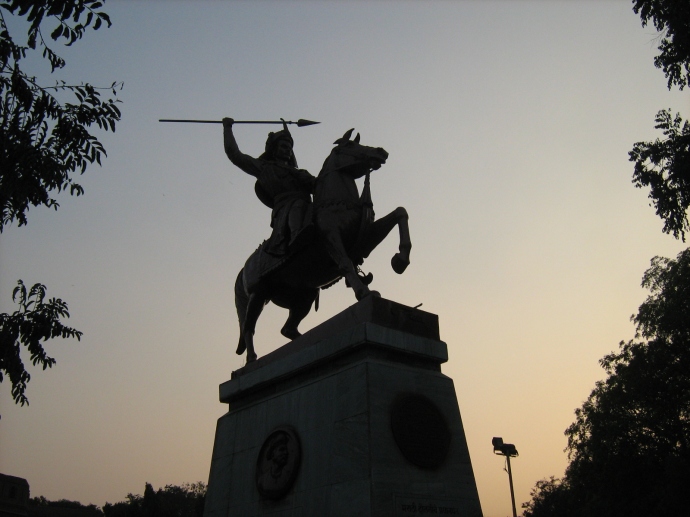
Bajirao Peshwa Statue
History was my least favorite subject in school. Why? because I was tired of the same content that was in the syllabus year after year. I was tired of reading about the same old Indian national movement and independence of India from the British.
However, later on when I was in college, I realized that history is not that bad and that there’s so much that we can learn from the events of the past and most importantly there are more stories waiting for you in the history books.
Recently, when I was watching Bajirao Mastani, a Hindi movie that focuses on the life of Peshwa Bajirao a.k.a Bajirao One, this concept struck my mind because although the movie does cover his life and his journey, it highlights more about his emotional turmoil and less about his achievements.
I’m not sure how interesting I can make this post, but I’m going to present you history in an interesting way, so that you never get bored half-way through.
Also, this series is a bit different from my regular travel post, but I will highlight places and destinations that are relevant to the warriors, after all what are warriors without kingdoms.
Introduction
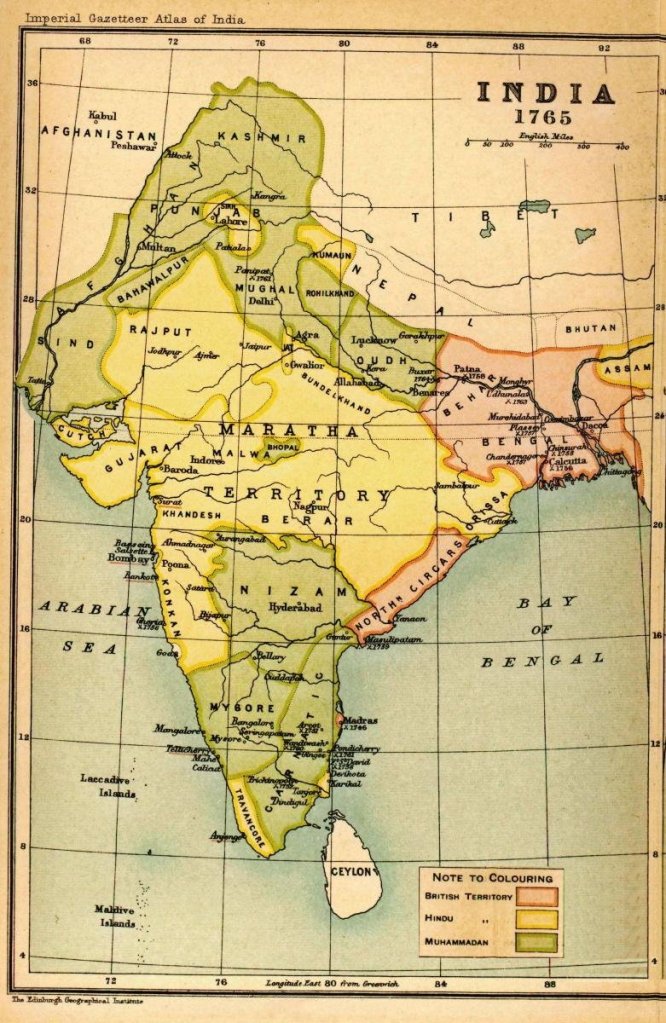
Maratha Empire in Yellow after the successful campaigns of Peshwa Bajirao. Mughal Empire in green.
Before I dive further into the topic, let me give a brief outline of the Maratha Empire to many of my international readers who might not be aware of it.
The Marathas is the Hindu warrior group that dominated the Western Deccan Plateau (currently state of Maharashtra) and they came up with the concept of Hindavi Swaraj (Hindu-Self Rule).
The term was first used by Chhatrapati Shivaji Maharaj, founder of the Maratha Empire and in simple words Hindavi Swaraj meant elimination of foreign influence and military from India. The Marathas aggressively revolted against the Mughal Empire or Mughal Sultanate, as Marathas believed that Mughals invaded Indian soil from the north beyond Himalayas.
Chhatrapati Shahu, grandson of the founder of the Maratha Empire became the ruler and it was during this time that the Maratha Empire rose to prominence. While Chhatrapati Shahu was still young, it was Peshwa Balaji Vishwanath hailing from the Marathi Chitpavan Brahmin family who took the empire under control in 1713 to prevent it from civil wars and persistent attacks by the Mughals.
Oh, by the way, let me bring to your attention that the word ‘ Peshwa’ means ‘Prime Minister’ in the current scenario. Peshwas are the Chief Executives to the King and they control the state administration, appoint key generals and diplomats and protect the empire from foreign invasion.
Selection of Bajirao as Peshwa
After the death of Peshwa Balaji Vishwanath in April 1720 at Saswad, close to Poona (now Pune), his eldest son Bajirao Ballal Balaji Bhat who was only 20 years old then, claimed to be the rightful successor to his position.
Although, very young at age, Bajirao had accompanied his father in various battles and had sufficient experience in battle strategy, administration knowledge and state diplomacy.
Despite opposition from many older generals, Shahu reposed his faith in the young Bajirao. A daring decision at that point in time.
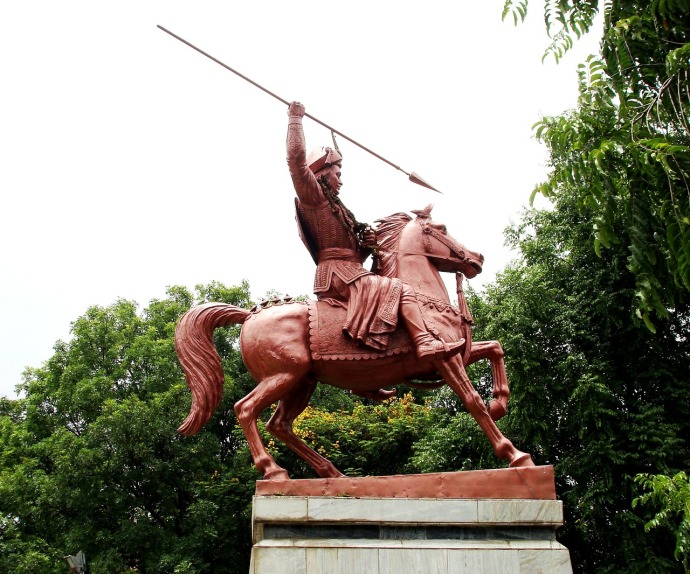
Peshwa Bajirao
The Killing Machine – Peshwa Bajirao
So, what makes Peshwa Bajirao One so distinct from other Peshwas in the Maratha Empire?
Well, he is considered to be the best strategist, a dashing horseman and had invented the concept of lightning fast cavalry (horse riders)which made him an efficient killing machine that stops at nothing.
While most Peshwas and kings would focus on fighting with large armies and elephants, and heavy artillery and food supplies, Bajirao’s army was solely composed of cavalry with no luggage to slow it down.
The daring feats of the nimble-feet Maratha cavalry soon became a trademark and attacked Mughal army fiercely out of the blue. With rapid troop movement and simultaneous attacks from different corners of the battlefield, Bajirao would keep the enemy off balance and cut the enemy supply lines to bring it to its feet.
His Campaigns
From 1723 to 1728, Bajirao decided to turn his attention towards Malwa (one of the kingdoms under the Mughal rule) along with his younger brother Chimaji Appa and other top generals.
After a fierce battle which was led by Chimaji Appa, his army defeated the Mughals at the Battle of Amjhera on November 29, 1728. By 1729, Maratha forces had occupied the territory which is now the present day state of Rajasthan.
In 1728, a Mughal force led by Muhammad Khan Bangash attacked Bundelkhand and imprisoned Raja Chhatrasal (King of Bundelkhand). Chhatrasal quickly summoned Bajirao to come to rescue who was busy in Malwa at that time.
In March 1729, Bajirao responded to Chhatrasal’s request and galloped his way to Bundelkhand, defeated Bangash and restored Raja Chhatrasal as the ruler of Bundelkhand.
In return, Chhatrasal assigned Bajirao a large jagir (feudal land grant) and also married his daughter Mastani to him. At this point, Bajirao was already married to Kashibai and Mastani becomes the second wife of Bajirao, on which the recent ‘Bajirao Mastani’ movie was made.
Bajirao also considered Portuguese as a foreign power invading India. He accompanied his brother Chimaji Appa who attacked the Portuguese regions near Bombay (now Mumbai).
Chimaji Appa successfully captured the regions of Thane, Belapur, Parsik, Dharavi, Arnala, Versova and Bassein (now Vasai) in 1739.
His Base of Operations
While Bajirao’s father operated and managed to operations from Saswad, in 1728 Bajirao decided to move his base of operations to Pune. He also started the construction of Shaniwar Wada (literally means Saturday Residential Complex) which was completed in 1732.
Initially, I was quite curious about its odd name, but on further research I found that the opening ceremony was performed on January 22, 1732 and it was a Saturday, hence the name.
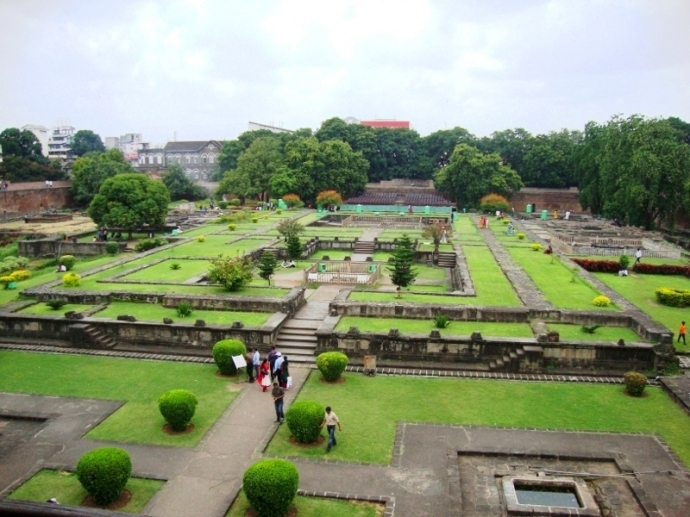
Shaniwar Wada Enclosed Garden
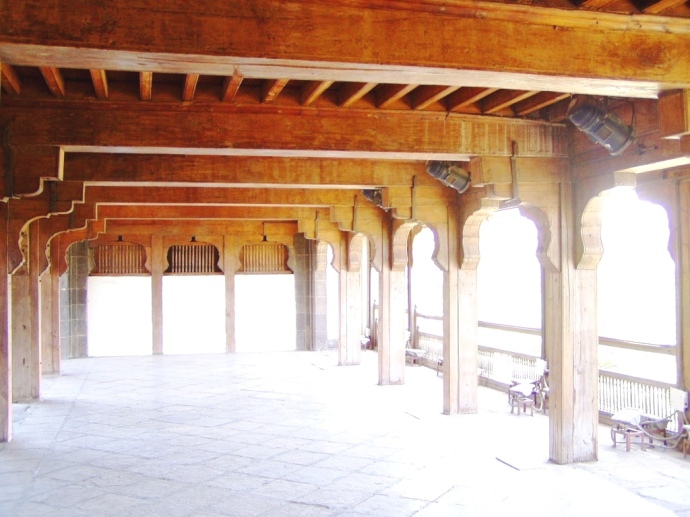
Shaniwar Wada Balcony
Shaniwar Wada has five gates, nine bastion towers, enclosed garden complex, fountains and reservoirs and fortification walls. By 1758, there were at least thousand people living inside the Shaniwar Wada premises.
Out of the five gates, Dilli Darwaza (The Delhi Gate) which also serves as the main gate is the most striking of all.
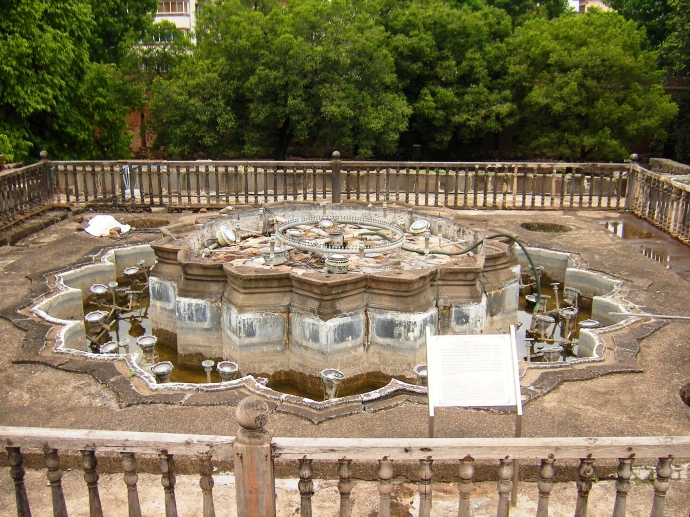
Hazaari Kaaranja – Fountain of Thousand Jets

Outer Wall of Shaniwar Wada Complex
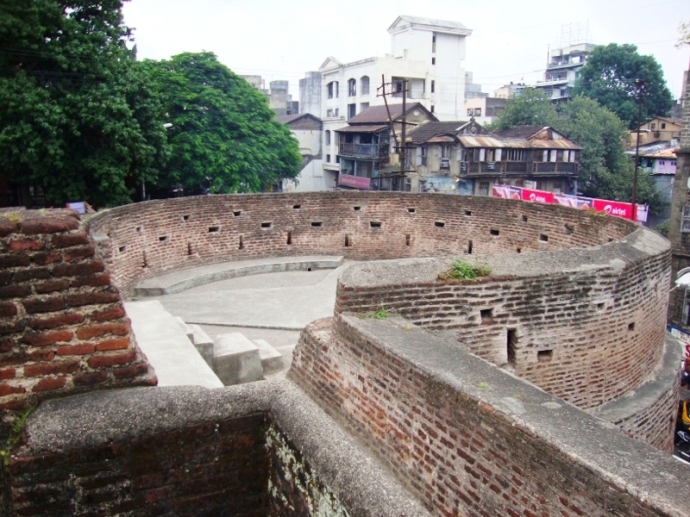
Shaniwar Wada Bastion
Dilli Darwaza faces northwards towards Delhi and it symbolizes Bajirao’s growing ambition against the Mughal Empire that ruled over Delhi. The gate has massive doors with 72 (12 inch) steel spikes to discourage charging elephants ramming the gate.
The bastions right above the gate has arrow-loops and machicolation chutes through which boiling oil could be poured on raiders.
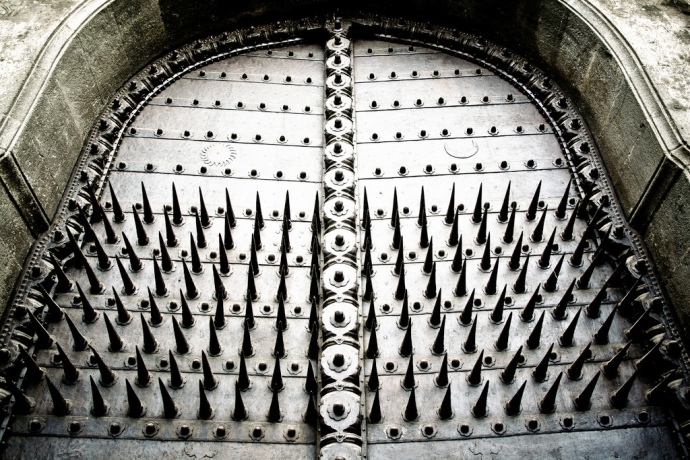
The Mighty Delhi Gate
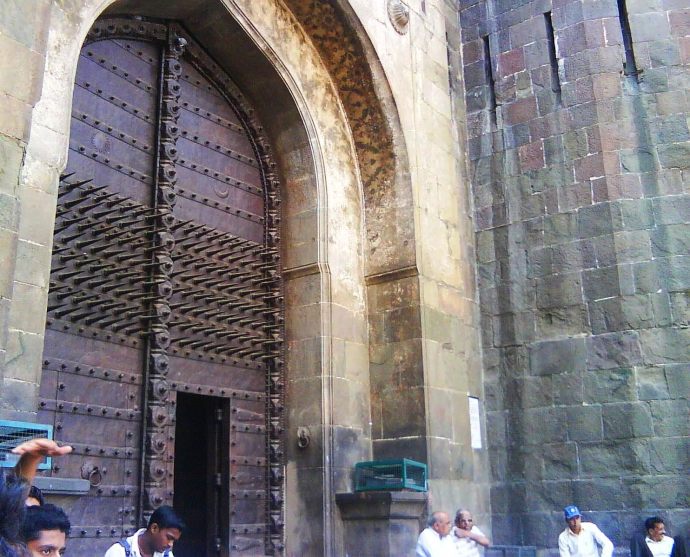
Dilli Darwaza with Man-Size Door
The right door has a small man-sized door to allow small army enter and exit without opening the entire gate. As another security layer, even if the entire massive gate is broken down, the charging army has to take a sharp right and then left to enter the central complex.
This offers the defending army to buy some time and have a clear opportunity to strike fiercely and launch a counterattack the recapture the gate, an exceptional strategy hidden in the architecture of the structure.
During the same time when Shaniwar Wada was built, Bajirao was busy establishing Maratha control over all of Gujarat.
As per the history books, Bajirao fought 41 battles in a brief military career spanning 20 years and is reputed to have never lost one. However, the Battle of Palkhed stands out as his best in terms of warfare tactics and strategy and brute strength.
Battle of Palkhed
The roots of the battle date back to 1713 when Chhatrapati Shahu became the ruler and appointed Peshwa Balaji Vishwanath (Bajirao’s father) as his Peshwa (minister) and together they managed to break into the territories of Mughal Empire.
In 1724, Muhammad Shah was appointed as the Nizam-ul-Mulk (Governor of the Deccan). The Nizam decided to use the growing polarization between the factions of Shahu and Shambhaji Two of Kolhapur (Shahu and Shambhaji were cousins, but had different ideologies).
The Nizam supported the Shambhaji faction to uproot Chhatrapati Shahu from being the ruler of the Maratha Empire and replace it with Shambhaji.
Nizam decided to make his first move in 1726 and he left Delhi and made a southward journey with his powerful army loaded with artillery, food supply and women that accompanied on his campaigns.
Sensing the incoming danger and attack from the north, Chhatrapati Shahu declared a war on the Nizam in 1727 and asked him to step back.
The Nizam immediately accepted his challenge of war and continued his journey south towards Shahu’s capital, Satara.
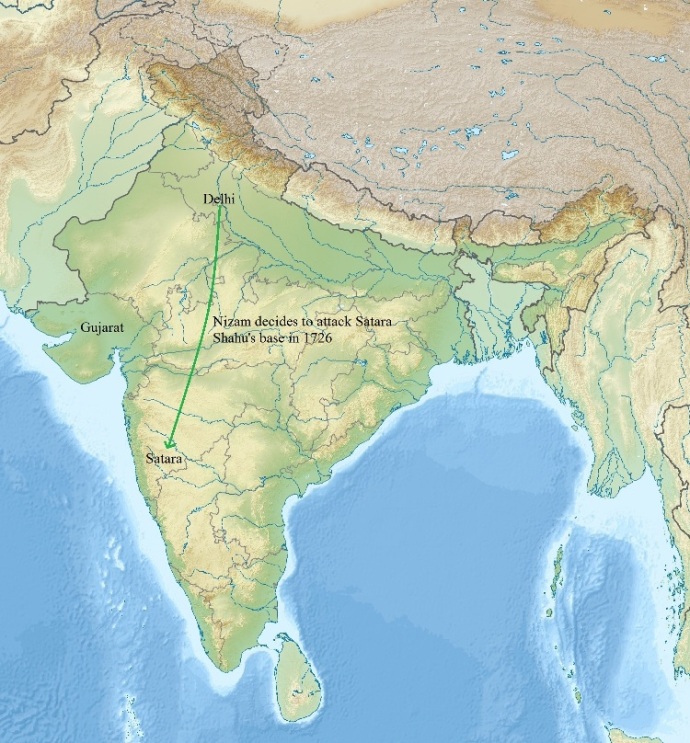
Nizam Marches from Delhi
On seeing the imminent threat, many of the generals of Shahu deserted him and joined his cousin Shambhaji who was supporting the Nizam in this battle.
Shahu with his family leaves the capital city and hides in the Purandar Fort, and immediately summons Peshwa Bajirao who at that point in time was busy with other campaigns in southern part of India.
Shahu commands Bajirao to go to Satara and defend the capital city from the incoming attack, but Bajirao has a different gameplan altogether.
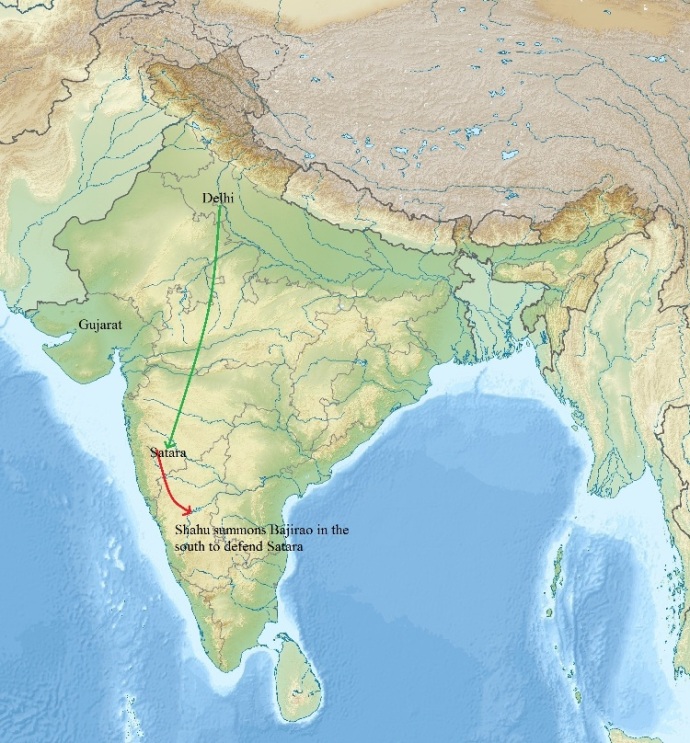
Shahu summons Bajirao in South to defend Satara
Wasting no time, Bajirao gallops north and captures Gujarat and convinces the Mughal King of Gujarat to join him or face the consequences. The Mughal King agrees not to attack Bajirao, when Bajirao attacks the Nizam. Thus, eliminating the chances of any future retaliation from neighboring state.
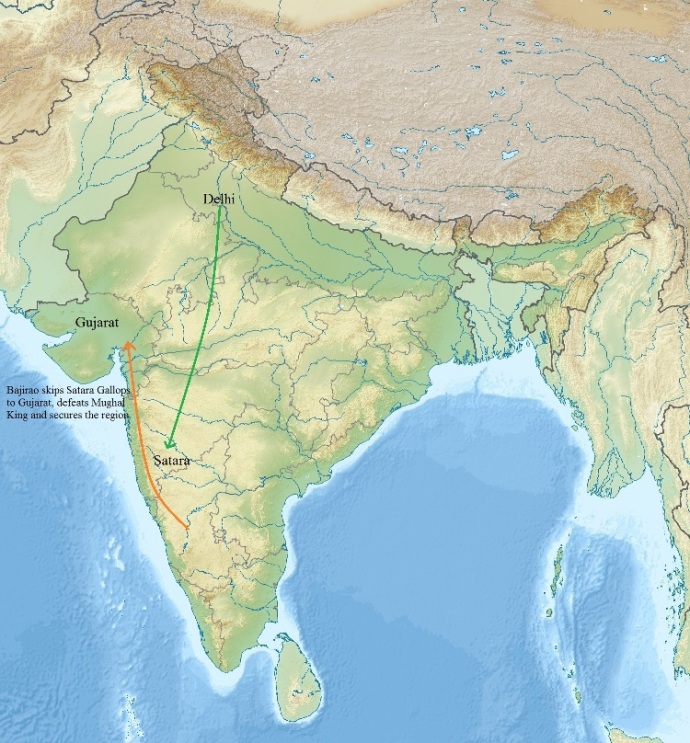
Bajirao secures Gujarat
He then gallops quickly to Malwa and attacks the rear portion of Nizam’s large army, thus cutting off Nizam from retreating into Delhi and cutting down a certain portion of the army.
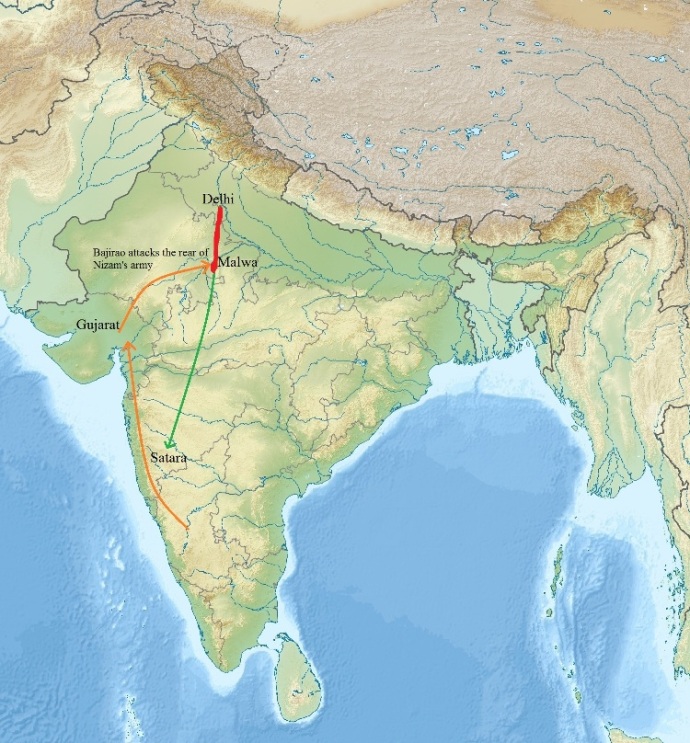
Bajirao attacks the rear of Nizam’s army
He then races his cavalry into Nizam’s main city Aurangabad, which was also Nizam’s treasury. Nizam could no longer ignore threat and he decides to abort his campaign to save his main city.
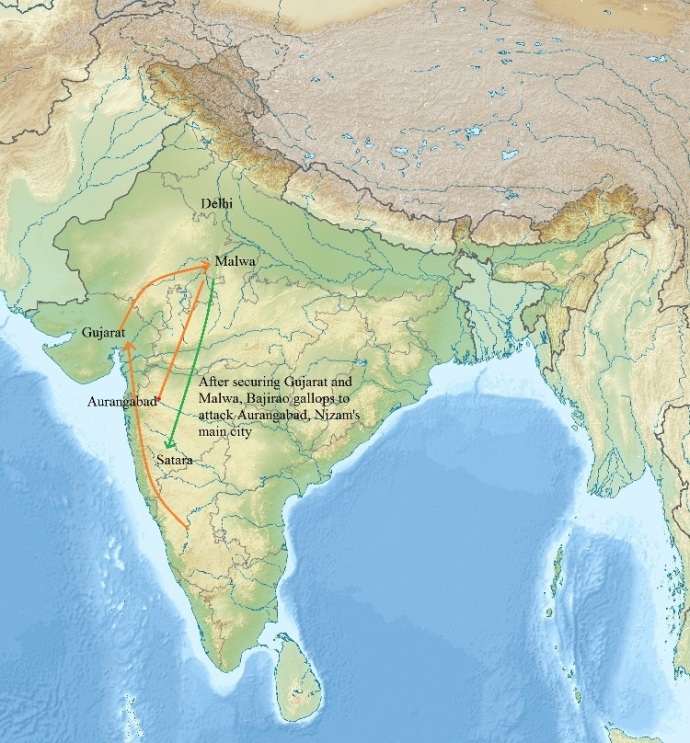
Bajirao attacks Aurangabad
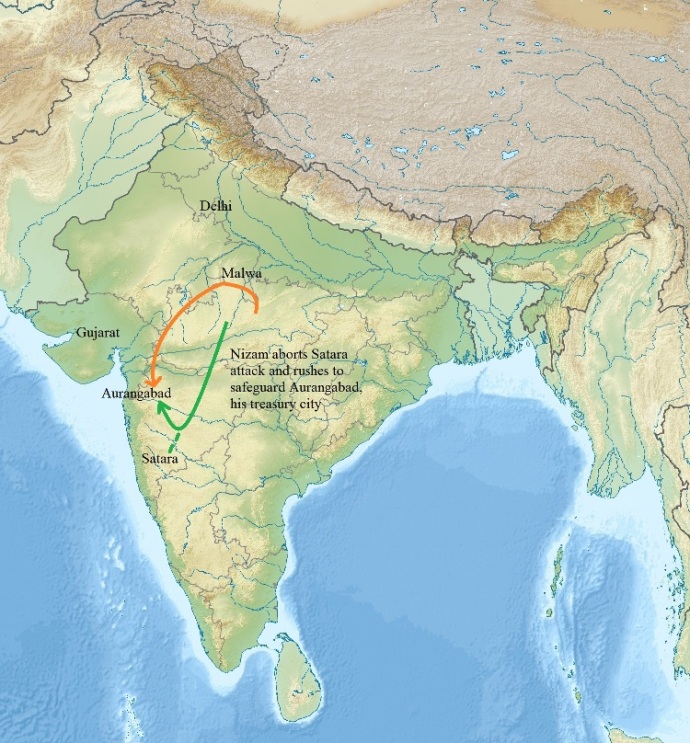
Nizam aborts Satara, rushes to Aurangabad
He pursues Bajirao’s swift cavalry in order to defeat it, but Bajirao’s lightning speed cavalry is nowhere to be found. Finally, the news arrives that Bajirao’s cavalry has been spotted south of the Godavari river.
In order to defeat and capture Bajirao, the Nizam decides to leave behind his powerful artillery which was slowing down his movements and marches ahead to pursue Bajirao’s army with a limited army.
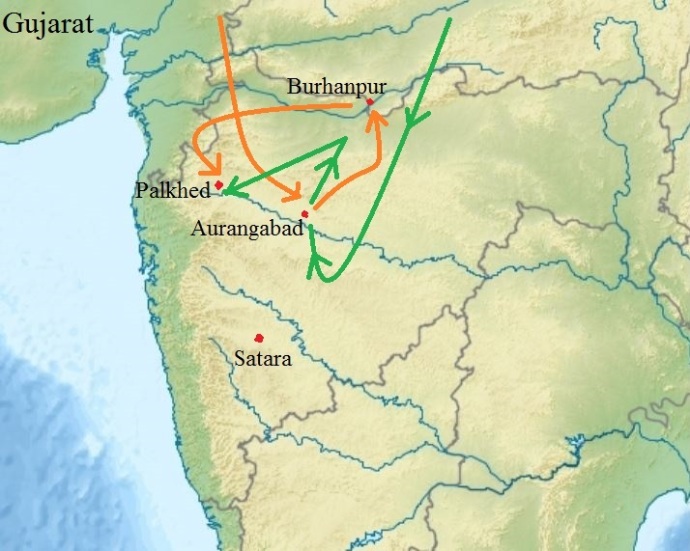
They meet at Palkhed
In a turn of event, Nizam realizes that his limited army has been cut off from supplies and is struggling with water scarcity issues for days and weeks.
On seeing that the Nizam’s army is losing, Bajirao decides to take a U-turn and attack the following Nizam’s army which is now in a situation of disadvantage and scattered.
He also immediately summons his other generals Malhar Rao Holkar and Ranoji Shinde to converge at Palkhed for a simultaneous multi-directional attack on Nizam’s army. Bajirao won the Battle of Palkhed on February 28, 1728.
The Raid of Delhi
By 1735, Maratha Empire flags were flying all over Malwa and Gujarat, but some of the regions were still under the influence of Mughals and they disregarded the right of Peshwas the collect chauth (chauth literally means one-fourth, but in the context it means tax).
To have a conversation with the Mughal, Bajirao decides to march into Delhi in March 1737. However, he splits his army into two contingent before he marches towards Delhi.
The other contingent is then attacked by a larger Mughal army led by Sadat Khan. After defeating one fraction of Bajirao’s army (which he assumes is the entire lot) he sends a victory message to other kings in Delhi and they move out of Delhi to join Sadat Khan in his celebrations.
Without a warning, Bajirao with his remaining cavalry dashes into Delhi sending the city into a state of panic. Bajirao loots the treasury of various Mughal kings as a compensation for showing him disrespect and not allowing Marathas to collect the rightful tax.
However, Delhi was never without a resource and had a large number of calvary and armed infantry to counterattack. The Mughal army now was led by Amir Khan who was more on the defensive and he ordered his men to be placed at strategic locations for another surprise and swift attack from Bajirao.
By dawn, the Mughal army was set to counter the incoming Maratha attack, but surprisingly there was no attack.
The Mughal commander decided to stay defensive rather than going after Bajirao, but Mir Hassan Khan, Mughal army’s young and dashing cavalry commander accused the commander of cowardice and secretly gathered 2000 horsemen and went charging after Bajirao.
At this point, Bajirao quickly splited his army only to converge at a strategic point. He waited for the incoming cavalry attack led by Mir Hassan Khan in the open plains.
Once the Mughal cavalry was within a range of his attack, Bajirao orders his trademark multi-directional cavalry attack which leads to a total rout. Bajirao and his cavalry killed 12 Mughal nobles, 600 soldiers and earns a war booty of 2000 horses and several firearms.
The Mughals opens parley and the Marathas secure the provinces of Malwa as well as the right to collect chauth of several provinces.
Battle of Bhopal
Considered as the largest pitched battle fought in India of the 18th Century, Bajirao decides to strike at the heart of the Mughal Empire which eventually leads to the Battle of Bhopal.
After the raids of Delhi (in March 1737), the Mughal Emperor was furious and decided to strike at the heart of the Maratha Empire with one mighty blow.
To ensure swift and guaranteed victory, the Mughal Emperor decided to make alliances with The Nawab of Awadh, Rajputs of Amber and Nawab of Bhopal. The Mughal Emperor also calls in the Nizam of Hyderabad (the same Nizam who lost to Bajirao in the earlier Battle of Palkhed) to avenge his defeat.
The war strategy was to club all the four armies together at Bhopal and the combined strength of the army would immediately swell to 200,000 and outnumber Bajirao’s army of 70,000 men.
While the 3 armies would attack from the north, Nizam’s attack from the south-side would attack the rear side of Bajirao’s army leaving him completely vulnerable.

The War Plan of Mughal Alliance
At this point in time, Bajirao was busy fighting the Portuguese in Bassein (Vasai) with his brother Chimaji Appa, but decides to make a move at once when they get the news of the incoming attack.
Bajirao quickly moves north while he orders his brother to keep check on the attack from the south. Bajirao summons his best men Yashwantrao Pawar and Malharrao Holkar to join him on the way north adding another 10,000 fighting men.
Bajirao’s army strength now swells from 70,000 to 80,000 men, but still not enough to take on the combined forces of Mughals. So, Bajirao comes up with another strategy.
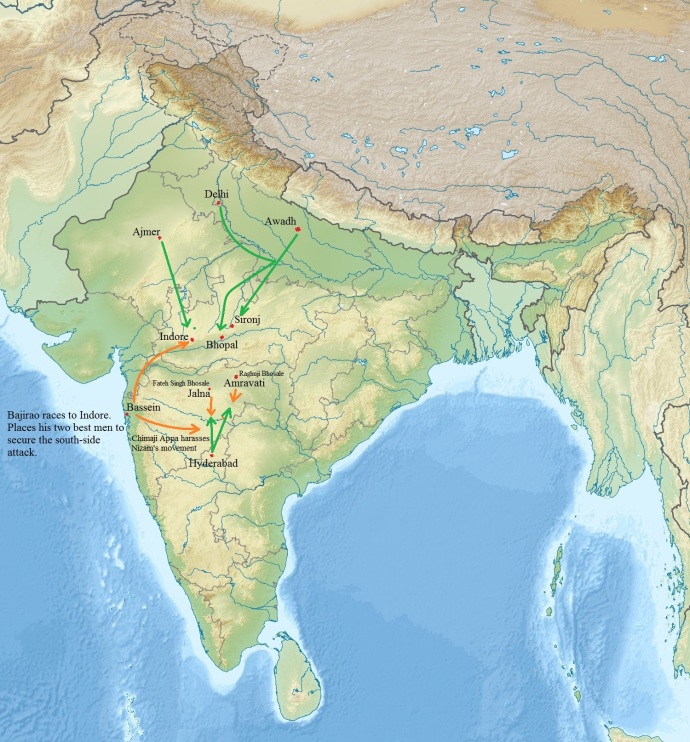
Bajirao Secures South-side Attack, Rushes North to Indore
Bajirao places two of his best fighters Fateh Singh Bhosale in Jalna and Raghuji Bhosale in Amravati. The Nizam of Hyderabad is now blocked from both sides. Chimaji Appa (Bajirao’s brother) harasses Nizam’s movement from west direction in the south.
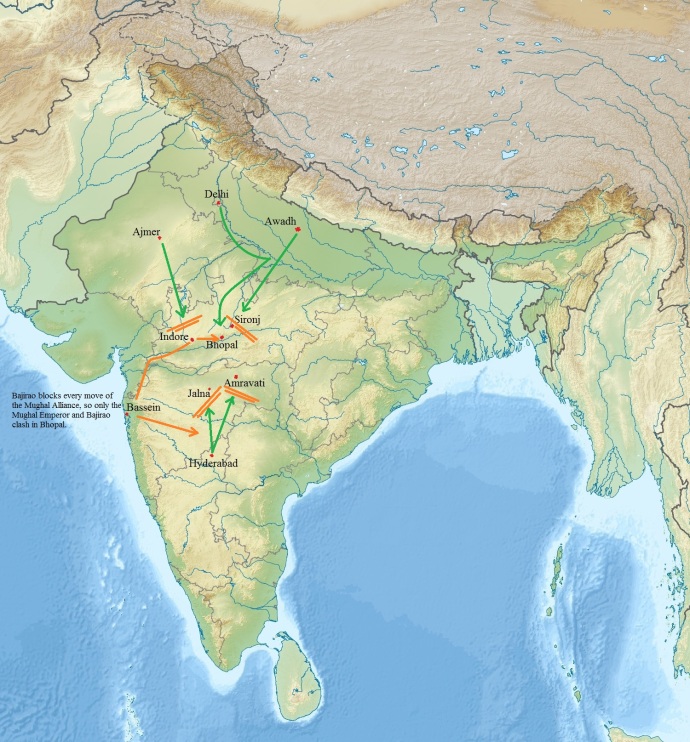
Bajirao isolates the Mughal Emperor in Bhopal
Bajirao places Malharrao Holkar at Indore to defend the attack from Rajputs of Ajmer from the north-west, while Yashwantrao Pawar captures Sironj on the north-east side to take on the Nawab of Awadh army, isolating the Mughal Emperor in Bhopal with the Nawab of Bhopal.
In December 1737, Mughal Emperor halts at the great lake in the city (which still exist), but soon retreats into the fort. Bajirao makes no mistake and blocks access routes to the fort, cutting down the supplies of the Mughal army.
With weeks and months without supplies, the Mughal army has no option but to utilize the limited resources available in the fort. After a month of starvation the Mughal Emperor was forced to come to terms with Bajirao at Doraha and the fort was captured by the Maratha army.
The Battle of Bhopal remains a historic event because it was not just a well executed warfare strategy by Bajirao, but it made the Maratha Empire, the sole power in Central India. Bajirao also managed to extract 50,00,000 from the Mughals as war indemnity.
It was during Chhatrapati Shahu’s and Bajirao’s era that Pune gained importance as it became their base of operations. The Peshwas not only turned the city from a small rural area into a city of political importance, but also developed it with construction of various bridges and temples and aqueduct that led to the prosperity of the city.
After the British took over, the city grew under the East India Company and today has become the twin-city of Mumbai.
Bajirao breathed his last on April 28, 1740 at the age of 39. He died of sudden fever on the banks of Narmada River in Khargone district while he was on his way to Delhi for inspecting his acquired land.
Apart from the fact that he was a born tactician, shrewd commander, keen horseman and exceptional fighter, many scholars believed he was a true leader and the incarnation of Hindu energy that propelled Maratha Empire like no other.
While Chhatrapati Shivaji Maharaj is considered to be the founder of the Maratha Empire, Bajirao in every sense was the true torchbearer of Shivaji’s dream of Hindavi Swaraj.
12 comments
This is a fascinating account of some very important military history. Thanks for the effort. The photos are beautiful. As I was reading this, I thought “this sounds like modern tank warfare strategy” so I searched on that and found that some of these battles were mentioned in Field Marshal Montgomery’s book on warfare. He was Britain’s greatest tank commanders.
Yeah. Many of Bajirao’s warfare tactics have been adopted by various other Indian fighters as well, I’m sure many other people must have taken clues and ideas from his battle strategies and implemented in their own style. So, what do you think of this? Good, Bad, Average, Too Long, Too Intensive. I mean this is the first time I attempted something like this, so not sure if I did it right.
You did a very nice job with this. I love history, I love military history, so I’m an easy target, but this was very easy to read and I enjoyed the pictures and, especially the maps. I think without the maps, and a working knowledge of India geography, I would have been lost.
Thank you Dan. I’m glad you liked it. When I began my research I had to decide what to include and exclude otherwise there would be too much content. Next I had to incorporate the maps because without it even Indian readers won’t understand what I am saying.
While I am not a fan of history as it oertains to wars, conquerers and occupations, I do enjoy knowing the evolution of the populactions and cultures of the world which is, of course, directly affected by this very history. You always do a precisely interesting job of presenting fact with curiosity satsifying tidbits. The photos, as always, as beautifully matched to your content. I only would prefer to be sitting and listening to you tell me this information. Then Sarah and I could visit! Nice job.
Thanks Cheryl for visiting and reading the post. Yeah, I realized from the response that not many of my readers are fond of history, although I tried to make it as interesting as possible with maps and war stories. I will switch back to my regular travel posts which I believe are more loved by readers. Yeah, you can fly to India and then you and Sarah can go strolling the streets and mountains, you both are passionate about nature so you have plenty to talk about. 🙂
And bring our cameras of course! 😊
A detailed account on the wars fought by the Great Bajirao in Maharashtra and all over India. I love the hard work and dedication put in sharing the history:)
Thanks Vishal.
Incredible account of the history and power of this place ~ and the photographs were fantastic. Thank you very much for taking the time to put this together so well, so completely 🙂
Thank you for visiting and reading my post. I’m glad you liked it.
[…] concepts to make my travel blog interesting. Last time, I tried to infuse history with travel in my Forgotten Warriors Lost Kingdom post, but it didn’t get the kind of response I expected. This time I am doing nothing much, but […]